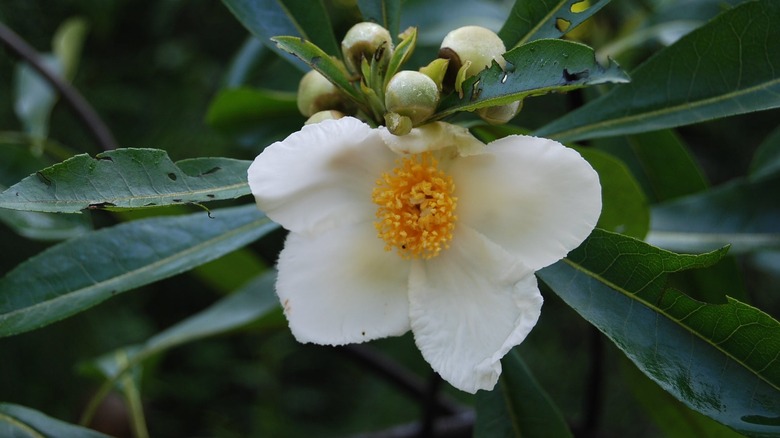Beautify Your Yard With A Rare Fast-Growing Flowering Tree That Smells So Sweet
The best yards engage all of your senses. Leaves rustle, grass touches your toes, colorful blooms draw your eyes, berries beg to be eaten, and fragrances evoke memories of freshly cut lawns or the faint aroma of lavender. The rare mountain gordlinia 'Sweet Tea' (x Gordlinia grandiflora 'Sweet Tea') appeals to most of these senses. Developed at the North Carolina State University in 2003, the tree is a beautiful, fast-growing, and sweet-smelling hybrid of Franklin tree (Franklinia alatamaha) and gordonia (Gordonia lasianthus), both members of the tea family. Together, the fragrance, botanical origin, and Southern heritage give the 'Sweet Tea' cultivar its name. Huge, showy white flowers with large yellow centers bloom in the mid-summer and last through the fall. In the autumn, the normally green leaves develop red and orange colors.
Mountain gordlinia is rare because it's not only an intergeneric hybrid, but it also has an extra set of chromosomes, which give its stunning, large white flowers their unique shape and size. While it can be challenging to grow, the fragrant tree is easier to establish than its parent, Franklin tree. Hardy in USDA zones 7 through 9, this semi-evergreen can double in size in a year, growing rapidly before reaching heights of up to 30 feet with a 10- to 15-foot canopy. It can be grown either as a multi-stemmed bush or as a tree. The 5-inch-wide, five-petaled flowers have been described as a whimsical take on a sunny-side up fried egg.
Growing Sweet Tea mountain gordlinia in your yard
Because of its striking flowers, consider growing 'Sweet Tea' as a specimen tree in a spot with morning sun and a little afternoon shade. The perennial trees do best in healthy soil enriched with organic matter and with a pH that's below 6.0. While 'Sweet Tea' prefers moist soil, it needs good drainage. Generally, mountain gordlinia is pest and disease free, but despite its greater resistance to Phytophthora pathogen than its parent, it is still susceptible to the illness. Watch for wilted leaves that become dull or change color — they indicate the presence of this type of water mold. To help maintain the tree's health, prune crossed branches during winter dormancy.
Butterflies, bees, and other pollinators are attracted to mountain gordlinia's flamboyant flowers. The tree is a standout when paired with more colorful plants that share its cultural conditions and moderate water needs. For example, if you grow hollyhock (Alcea rosea) alongside 'Sweet Tea,' its large red, yellow ,and purple flowers will bloom from June to August, and the profusion of colors in your garden will attract beautiful butterflies from late spring to the end of fall. Common lantana (Lantana camara), a shrub that can grow 6 feet tall, has bright flower clusters that range from gold and orange to purple and white, and would likewise complement your 'Sweet Tea.' Just note that common lantana is listed as invasive in several southeastern states and shouldn't be grown there.

